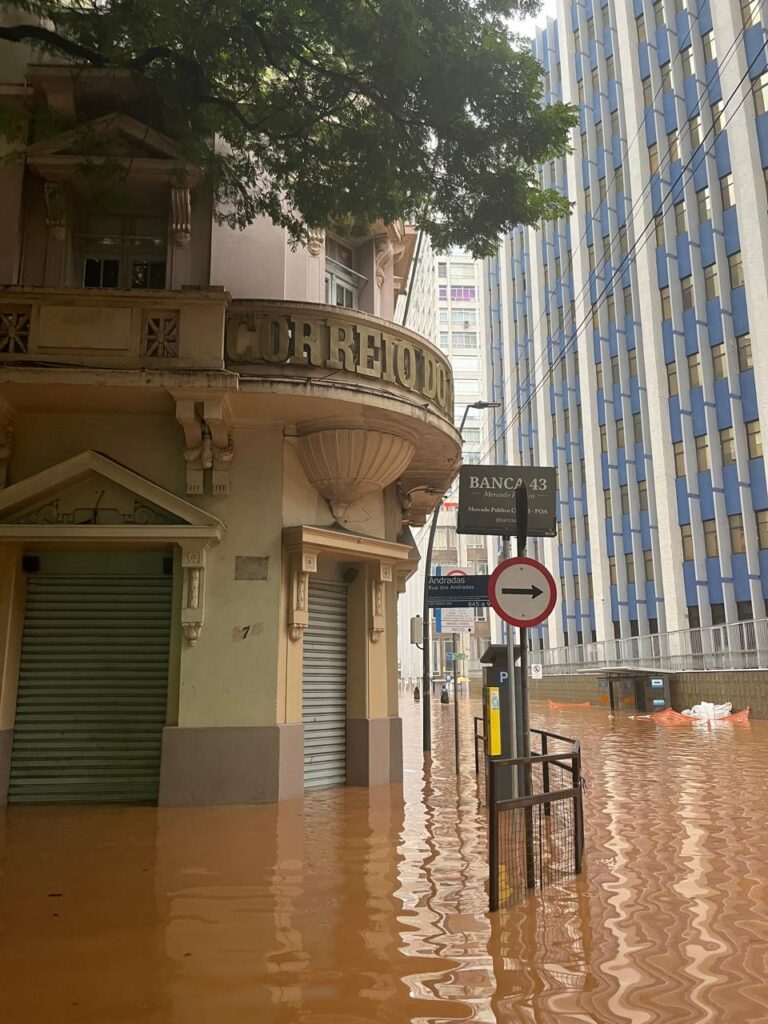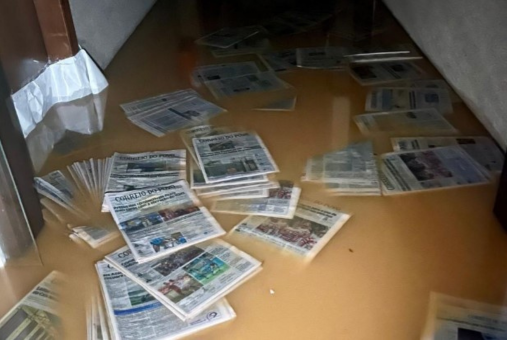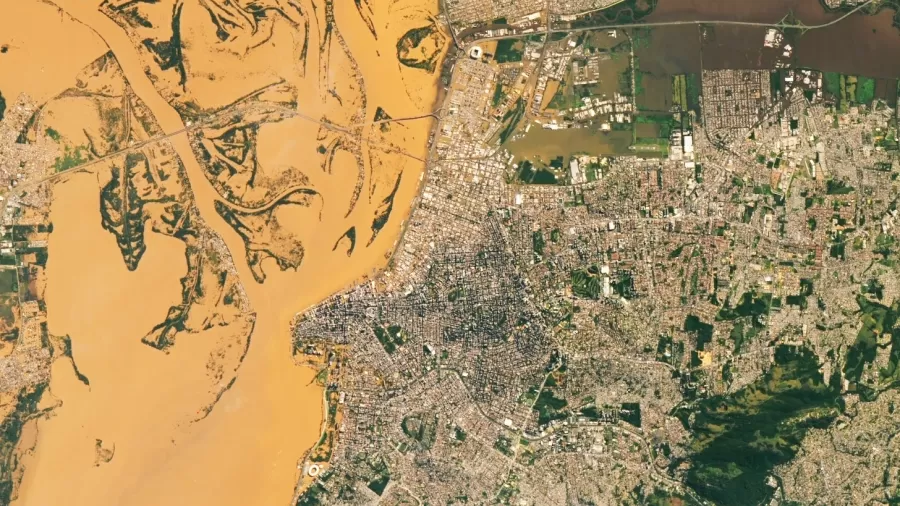Porto Alegre [the capital city of the Brazilian state of Rio Grande do Sul] was going through its seventh consecutive day of heavy rain on Friday, May 3, when the editor in chief of the Correio do Povo newspaper, 64-year-old Telmo Flor, found himself staring at a picture hanging on his office wall. The framed photograph was taken in 1941, during an unprecedented flood: it shows a woman with water down her shins, in front of the newspaper's headquarters – the Hudson Building, located in the Historic Center. Flor then went to one of the building's balconies and looked down onto Caldas Júnior Street. By that time, around 1 p.m., the muddy water had already reached the block in front of the building. The journalist spent the afternoon leading his reporting team and checking the level of the water flowing from the Guaíba watershed, which was advancing little by little, finding wide gaps in the retaining wall.
At around 2 p.m., the electricity in the neighborhood was turned off. Correio do Povo's generators, with enough diesel to keep the operation going for 48 hours, were activated and the team kept working at an intense pace, on several simultaneous fronts. With the information that the newspaper's printing plant, located in the Fourth District, had been inundated by the flood, Flor concentrated the coverage on the publication's website, but didn't give up on releasing an edition in flip format – the digital version of the printed newspaper, which has been published daily, open to non-subscribers (the May 9 edition has 20 pages, almost all of which are dedicated to the coverage of the floods).
Since then, distribution of the print newspaper, which circulates every day of the week in tabloid format, has been suspended. In this printing plant, created in 1997, the rotary presses were hit by the water and damage will be measured only in the future.
That afternoon of May 3, the city council issued a warning that the neighborhood should be evacuated. Even with this mobilization, Flor hoped that the water wouldn't reach the building. Even so, while he was closing the edition, he met with the team's graphic designers to tell them to take home the main computers, where the layout programs and systems were installed. On the first floor, where the sales, training and maintenance departments are located, as well as the reception and garage, there was a small task force to get whatever they could onto the tables: from chairs and computer CPUs to bundles of previous editions of Correio and documents.
From time to time, Flor went outside, worried. In the early evening, he even measured the water level and found that the building was about 11 inches short of being flooded. At around 9 p.m., he and the seven colleagues who were still at the newspaper said goodbye. Despite all the inconvenience of that day and the advance of the water, the editor in chief planned to return to the newspaper the following day. In the early hours of Saturday morning, May 4, however, he received the news that the waters had now invaded the property.
“It was a mixture of shock and dismay. I've worked in this building for 39 years. I looked at the photo from 1941 and couldn't believe the possibility of water entering our building again. It's shocking,” he told piauí. “When we said goodbye, someone said: ‘We'll be back in three days.’ Another said: ‘During the pandemic, we said the same thing and it went on for two years.’ It's like the pandemic. And it's scary.” In the following days, the level of the Guaíba hit about 17.5 feet, surpassing the flood of the 1940s, which reached about 15.6 feet.

The Hudson Building, Correio do Povo's headquarters, on May 4.(Photo: Pedro Dreher/Correio do Povo)
When he heard that the newspaper's headquarters had been flooded, Flor bought a pair of wellies and set off for the site on Saturday morning, thinking he'd get inside the building, see the damage with his own eyes and assess what could be done. He couldn't even get close to the address. Several streets leading to the historic center were flooded, preventing cars from passing through. A colleague who managed to reach the building, however, reported the damage. On his cell phone, Flor received photos showing flooded rooms and corridors, with editions of the Correio floating in the murky water. In the following days, the flood reached a height of 3 feet. The newsroom, which is on the second floor, was not affected.
With no alternative, the journalist returned home, to a small condominium located in the Pedra Redonda neighborhood, which still had electricity but no water. From there, he headed up the new edition of the newspaper, once again in flip format. Although the editors had taken some of the computers home, the team had limited access, as the centralized systems on the server were out of operation, since the building was without power. There was the possibility of access via the cloud, but only to a limited extent.
On Sunday, May 5, the obstacles worsened. With a reduced team, the edition was closed at 4 a.m.
As well as being at the epicenter of a humanitarian tragedy, the director was trying to balance his efforts to keep the coverage on track with the personal and professional needs of his team. On Monday, May 6, he had difficulty even knowing exactly how many professionals he could count on – he estimates that of the eighty people in the newsroom, only around thirty had the structural conditions to work.
Many colleagues were displaced, had no electricity at home or were unable to get to a place with minimal working conditions. One of the cases that most worried the team was that of production coordinator Luciamem Winck, whose first-floor apartment was flooded. She lost practically everything. The water reached about 6 feet and she had to take refuge on an upper floor of the building. Even so, Winck planned to go to the state coast where she could work.
“You have to worry about your work, about your mission to inform. But we can't produce more victims. We can't put people at risk. Life is more important than anything right now,” Flor said. “It's not just news. Things are also happening to us. I have three teams that went to cover the countryside and they're stranded, unable to get home.”
Photojournalist Ricardo Giusti, 63, journalist Cristiano Abreu, 43, and driver Alexandre Soares, 54, left the Correio do Povo newsroom on the morning of April 30, aboard a Citroën C3, with the mission of reaching Santa Maria, which is about 186 miles from Porto Alegre. Along the way, they passed through other municipalities, such as Santa Cruz do Sul, which were already suffering from floods. They recorded the state of calamity: flooded streets, people being rescued from their homes in boats or airplanes. That day, however, they were unable to reach Santa Maria. Eleven miles from the city, the BR-392 highway was submerged.
“I counted: there were fifty trucks, as well as dozens of private cars. We had to spend the night on the road. It was a horrible night. Lightning, thunder and heavy rain all night long. Scary,” Giusti said. The trio slept in their own car: Soares and Giusti in the front seats and Alves in the back.
As the water didn't go down, on the morning of Wednesday, May 1, the team took a side road and made a long detour of around 155 miles, passing through four municipalities, to reach Santa Maria on the west side. The insistence was justified: President Luiz Inácio Lula da Silva and his entourage had decided to visit Santa Maria the following day. At the time, the rains had caused 13 deaths and 21 people were missing. On May 13, the number of confirmed dead reached 147, plus 127 missing and 2.1 million people directly affected.

Flooded floor on Correio do Povo's headquarters. (Photo: Pedro Dreher/Correio do Povo)
After covering the presidential mission and the effects of the disaster in Santa Maria, the Correio team began its return. At that point, in addition to the inconveniences of the disaster, the team faced another kind of setback. The group had only prepared for a two-day expedition. Each person had taken only a backpack with two changes of clothes and basic work materials – among the items, only one power bank (portable charger). While still in Santa Maria, they had to buy new clothes, anticipating that the trip could go on indefinitely.
On the evening of Saturday, May 4, the three professionals arrived in Guaíba, in the metropolitan region of Porto Alegre, but they couldn't go any further: they were stranded. The news they received said that 95% of Eldorado, a neighboring municipality, was flooded. The team began their journey there, but the highway was also flooded, preventing small vehicles from getting through. Giusti hitched a ride alone in an army truck and reached the critical point.
“You can't imagine the number of Eldorado residents who were on the side of the highway, with cars, camped out, waiting for something they didn't even know what it was. The situation of refugees, like we see in Europe,” Giusti said. There, the photographer documented residents being rescued in boats and helicopters, elderly people and children with water up to their waists, and animals being removed by volunteers. It's impossible not to resort to a cliché: “It was a war scene,” he said.
Despite having seen many examples of solidarity, Giusti was also amazed to witness looting. One such situation happened in a convenience store at a gas station. He says that when the owner saw the movement towards the products, he told the employees not to react. Army soldiers were on the scene, but no one intervened.
The work continued and, when night fell, the photographer couldn't find the army again. He took refuge in a makeshift shelter in a shed at a truck dealership. The next morning, he learned that there was to be a rescue operation in the municipality. He managed to return to Guaíba aboard a helicopter belonging to the Paraná Military Police. Only then did he meet up with his colleagues.
“I want my newspaper to have the best image, to better inform my reader,” explained the photographer, who couldn’t help but be moved by the coverage. “In a Grenal [classic soccer clash between Grêmio and Internacional], I, who support Grêmio, am a professional. I photograph both teams in the same way. But there [in the tragedy], there was no way. I get emotional, I'm not a robot. At that moment, all the photos have feelings,” said Giusti, who has been photographing for 40 years. On the morning of May 8, the team had been away from home for eight days. They were preparing to hitch a ride on an army helicopter, which would take them back to Porto Alegre.
The storms began on April 27 and soon became a humanitarian and social catastrophe. Since then, the municipalities of Rio Grande do Sul have recorded more than 31 inches of water, according to the National Water and Sanitation Agency (ANA), almost eight times the average expected for the month of May in the state. There are more than 79,500 people in shelters and 538,000 displaced. Of the 401 municipalities in Rio Grande do Sul, 447 reported problems resulting from the storm.
On the morning of Monday, May 6, when she heard that Correio's headquarters were still flooded, politics editor Mauren Xavier decided to turn her apartment into a “mini headquarters” for the newsroom, so that her colleagues could work. Located in the Cidade Baixa neighborhood, the building was without water, but still had access to electricity and the internet. Around 11 a.m., reporter Flávia Simões arrived, carrying her laptop, cell phone and other work equipment. Editor Carlos Corrêa started to head there, but there was no time. At midday, the electricity supply was interrupted, dismantling the “mini HQ.”
From the top of the fourth floor, Xavier looked out of the window and saw that the water level was high, although it was still a few blocks from the building. While her colleagues sought shelter in friends' houses, Xavier chose to go down to the street to understand what was happening. She saw a scene of desolation: people rushing out of their homes, a boy with water up to his thigh rescuing a cat and putting it under his sweatshirt. “You could see that dirty water advancing through the streets and people desperately looking for a bottle of water, willing to pay whatever it took,” the editor said, moved.

Satellite image shows flood in Porto Alegre on May 6. (Photo: Nasa)
Shortly afterwards, the authorities issued a recommendation that Cidade Baixa be evacuated. Xavier hurriedly packed a backpack, took her two cats and went to her mother's house in the Mario Quintana neighborhood, 40 minutes away. Although she was a politics editor, she had already been assigned to cover the floods, like the rest of the team. She took to the streets, reporting on the effects of the flooding and producing videos for social media. Amid the dimensions of the tragedy, the journalist was embarrassed to admit that she was suffering the weight of the episode she was going through, as if she had no right to complain because thousands of people were in worse conditions.
Correio do Povo was founded almost 130 years ago, in 1895, with the aim of being a more neutral newspaper between the two groups that prevailed in Rio Grande do Sul politics at the time, neither leaning towards the Maragatos (identified by their red scarves) nor the Chimangos (with their white scarves). As a symbol of balance, the newspaper was printed in a pinkish hue, becoming known by the nickname “the pink.” Since 1946, Correio has been based in the Hudson Building, on the street that would be named after the newspaper’s founder: Caldas Júnior. As well as Correio, the building also houses Rádio Guaíba – both are now companies of the Record RS Group. The newspaper also had an important literary vein, publishing names such as Émile Zola, Machado de Assis and, decades later, Mario Quintana.
It is the main competitor of the RBS group's Zero Hora newspaper, whose building was also partially evacuated due to the proximity of the flood (part of the technical team continues to work there, “in safety,” as the company explains, while most of the team works from home or from the headquarters of the TV Globo affiliate in another neighborhood. The daily edition is available free of charge on the website).
A graduate of the Pontifical Catholic University of Rio Grande do Sul, Telmo Flor started working in the Hudson Building in 1985. His first job was at Rádio Guaíba, but he was soon transferred to Correio. He worked in various editorial departments until, in 1992, at the age of 32, he was promoted to the position he still holds today, newsroom director. “I've slept here during several coverages, elections... The cliché goes: it's my second home,” Flor said. This career runs through his mind when he sees the headquarters flooded. The historic flood of 1941 is no longer just a picture on the wall.
On the night of May 6, Telmo Flor was exhausted. While rushing to lead the reporting, he was dealing with personal issues. He had to take in his son, daughter-in-law and their dog, who had to leave their home in a hurry. The condominium where he lives still had no water. To bathe and clean the house, the residents used buckets to remove the water from the swimming pool. The only drinking water in the house was sparkling. There are supermarkets in operation, but the mineral water has disappeared from the shelves.
After ending his conversation with piauí at 6:30 p.m., he still edited all the stories sent to him between late afternoon and early evening and tried to get back in touch with the colleagues he hadn't been able to speak to over the last few days. Finally, he planned the next day's coverage. During these days of crisis, he developed digestive problems and started taking anti-anxiety medication faced with water that resists receding even on days when the rain lets up. “We spend the whole day in anguish. We no longer trust the sun,” he said.
Flor knows it won't be possible to return to the newspaper's headquarters in the short term and has settled into a makeshift desk. “I can't risk predicting when the water will recede. But we know that information, especially alerts, can save lives. That's our motto. There are a lot of dedicated people – excuse the cliché – working their hearts out to keep the newspaper alive. And we're moving forward.”